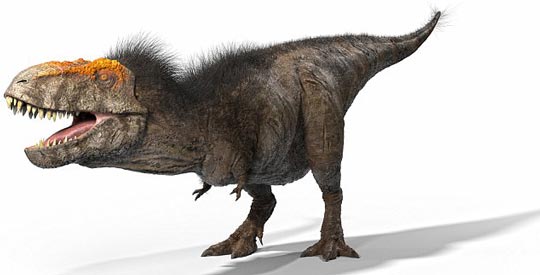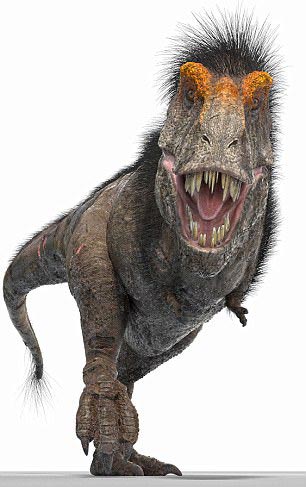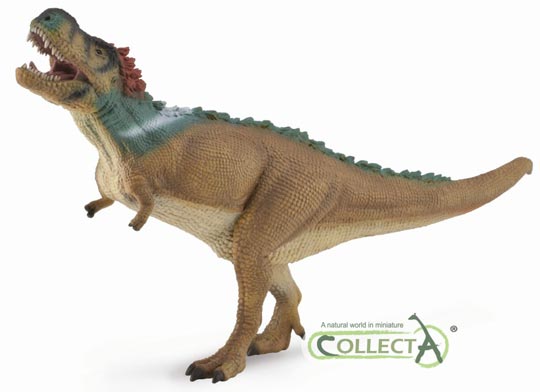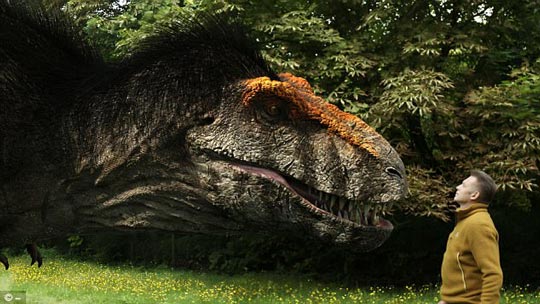Television Documentary Gives T. rex a Makeover
T. rex Gets a New Look for a Television Documentary
The most iconic vertebrate in the fossil record, Tyrannosaurus rex has been given a makeover as part of a new television documentary programme due to be shown on the BBC. The hour-long documentary entitled “The Real T. rex with Chris Packham” is due to be shown on BBC Two on Tuesday, 2nd of January. According to the latest scientific research, this formidable Late Cretaceous predator may have looked very different from the way it is usually depicted in books, television programmes and on the big screen.
An Illustration of Tyrannosaurus rex (2018)
Everything Dinosaur team members have known about the television documentary for several months, the aim of this programme is to update what T. rex might have looked like based on the very latest palaeontology, including studies of other feathered theropods and the publishing of a scientific paper on the skin of Tyrannosaurus rex.
To read about the forthcoming documentary: Rediscovering T. rex Television Documentary.
Confirmation of broadcast timings in the UK: New Time for Tyrannosaurus rex Documentary.
Covered in Bristles with a Markings Around the Eyes
The Tyrannosaurus rex makeover will not hold many surprises for dinosaur fans. Most of the information the programme divulges is not new, but for those viewers who think that the solitary, scaly hunter with a huge roar as in “Jurassic World”, is an accurate depiction, they are in for quite a shock.
A New Look for T. rex
This iconic dinosaur from the Hell Creek Formation of North America is depicted as having a sparse covering of bristle-like feathers, a scaly skin covered in dark blotches and brightly coloured, orange flashes directly above the eyes. Instead of a terrifying roar, this dinosaur was capable of producing a limited range of vocalisations, roaring is out, replaced by a virtually, inaudible low-frequency rumble, reminiscent of an elephant.
Over the course of the programme, presenter Chris Packham discusses with various experts what T. rex probably looked like and how it might have behaved based on the latest fossil evidence. It is not that surprising, but the consensus of opinion is that Tyrannosaurus rex had more in common with birds than it does with today’s crocodiles. Not an astounding revelation given that T. rex was a lot more closely related to birds than to crocodilians.
Covered in Dark Blotches
In the segment featuring Professor Julia Clarke (University of Texas), the skin colouration of this seven-tonne giant is discussed. Professor Clarke postulates that this animal was covered in dark patches. An analysis of fossilised dinosaur skin has identified structures similar to those that produce the natural pigment melanin. This suggests that T. rex could have been dark coloured and blotchy, perhaps to help break up its outline in dappled light, in a similar vein to the markings on some World War II battleships. The colouration of this dinosaur remains controversial, as the tendency to find structures that resemble melanin might reflect a bias in the fossilisation process.
The absence of a total body covering of feathers in an adult animal is explained by the concept of the rate of heat loss based on the ratio between surface area and volume. A large animal in excess of thirteen metres long, such as Tyrannosaurus rex would have had a large volume compared to its surface area. It would have lost heat to its surroundings more slowly than smaller animals.
Endothermic T. rex
Over-heating for an active predator could have been more of a problem rather than trying to keep warm, especially if T. rex was endothermic (warm-blooded). Hence, the lack of feathers on the body, a few stiff bristles and some tufts rather than a thick, shaggy coat. Younger animals with a larger surface areas compared to their volume, such as the sub-adult “Tristan” tyrannosaur that features in the programme, may have had a more substantial coat helping to insulate the animal.
The idea of a sparsely feathered T. rex has already been explored by model manufacturer CollectA. In 2018, they will be introducing a 1:40 scale replica of a Tyrannosaurus rex with fewer feathers than their current feathered T. rex model. In a direct comparison with modern flightless birds such as the Cassowary, the television documentary suggests that this dinosaur may have retained “a light patching of feathery bristles strategically placed for social display”.
Less Feathers on the New for 2018 CollectA T. rex Replica
The model (above) comes from the CollectA Deluxe model range.
To view this range of prehistoric animal models: CollectA Deluxe Prehistoric Life Figures.
Distinctive Markings Like a Bird of Prey
Detailed scans of the fossil bones suggest that these dinosaurs might have fought with each other, perhaps over food, mates or even to decide hierarchies within packs or family groups. The bright orange crests over the eyes also portray T. rex with more affinities to the Aves. Birds have colour vision and rely on colour for visual displays. The scientists argue that the thickened ridges found on the skulls of adult animals may represent the remains of crests or prominent lumps that were very colourful and used to show maturity, dominance and perhaps played a role in ritual displays.
Chris Packham Comes Face to Face with the New T. rex
Picture credit: BBC Media
To read an article on the study of the skin of T. rex: T. rex Sheds Its Feathers.
The Everything Dinosaur website: Everything Dinosaur.





